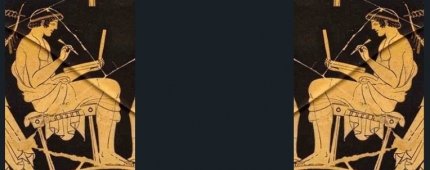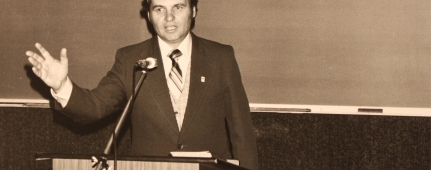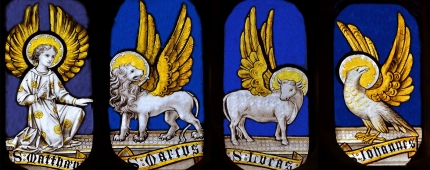Robert Gundry, Gaining Renewed Support from ETS, Declares Peter An Apostate in Matthew’s Gospel
by F. David Farnell, Ph.D.
Copyright © 2014 F. David Farnell. All rights reserved.
Note: This paper includes a discussion of Dr. Robert Gundry’s lecture titled “Peter: False Disciple And Apostate According To Saint Matthew” given at Westmont College on Oct. 6, 2014.1 This lecture can be watched here:
https://www.youtube.com/watch?v=QloN9EuOGXE
Part 2 of this article can be found here.
Introduction
In 2013, the Evangelical Theological Society (ETS) had as its theme “Evangelicalism, Inerrancy, and ETS.” The present writer had learned from direct eyewitnesses who were present that there was a strong call for Robert Gundry’s reinstatement as a member of ETS. Strong verbal cries as well as applause broke out in one particular session. This is not surprising, for troubling events have been occurring at ETS as it pertains to the degeneration of the orthodox meaning of inerrancy for many years now. Even in the present writer’s days as a doctoral student from 1986 to 1990, ominous developments among its members regarding changes in evangelical definitions of inerrancy were gaining more frequency. These developments manifested themselves in many of the classes attended, which are now conducted by prominent ETS members who have risen to take on influential roles at the Society.
Another troubling event at the 2013 gathering was the Presidential address delivered by Robert Yarborough, Professor of New Testament, Covenant Theological Seminary. Wherein Yarborough praised another ETS scholar, Craig Blomberg, for his latest book, Can We Still Believe the Bible? (Baker 2014).2 Yarborough’s high praise for Blomberg are as follows:
Excellent recent books demonstrate the cogency and vitality of a reverent and indeed an inerrantist stance. Two such books were made available to me in pre- publication form for this address.
1. Craig Blomberg, Can We Still Believe the Bible? The first is by Craig Blomberg, Can We Still Believe the Bible? An Evangelical Engagement with Contemporary Questions. Blomberg takes up six issues that he finds foundational to an affirmation of the Bible’s comprehensive credibility like that affirmed by this society.18 In each of these categories, Blomberg cites the literature of those who reject a high view of the Bible’s veracity or authenticity. As he points out, those critical of the Bible’s truth often do not return the favor, stonewalling evangelical arguments and publications as if that class of scholarship did not even exist. Blomberg calls attention to the best studies he can find that reject his viewpoint. He then argues for the position from his inerrantist standpoint. He notes, “Not a single supposed contra- diction” in Scripture “has gone without someone proposing a reasonably plausible resolution.”19 He also notes the irony that some are abandoning inerrancy today when “inerrantists have the ability to define and nuance their understanding of the doctrine better than ever before.”
This book is refreshing and important not only because of its breadth of cov- erage of issues, viewpoints, and literature. It is evenhanded in that both enemies of inerrancy and wrong-headed friends are called on the carpet. Blomberg revisits incidents like Robert Gundry’s dismissal from this society and the kerfluffle over a decade ago surrounding the TNIV and inclusive language. He does not mince words in criticizing those he sees as overzealous for the inerrancy cause. Nor is he bashful in calling out former inerrantists who, Blomberg finds, often make their polemical arguments against what they used to believe with less than compelling warrant. I predict that everyone who reads the book will disagree strongly with the author about something. At the same time, the positive arguments for inerrancy are even more sub- stantial. It is clear that Blomberg is not content with poking holes in non-inerrantist arguments. He writes, “I do not think one has to settle for anything short of full- fledged inerrantist Christianity so long as we ensure that we employ all parts of a detailed exposition of inerrancy, such as that found in the Chicago Statement.” Or again: “These Scriptures are trustworthy. We can still believe the Bible. We should still believe the Bible and act accordingly, by following Jesus in disciple- ship.”22 I am skimming some of his concluding statements, but the real meat of the book is inductive demonstration of inerrancy’s plausibility based on primary evidence and scholarship surrounding that evidence. If only a book of this substance had been available when I was a college or grad school student!3
Why does the present writer mention these troubling statements and events together? Because support for Gundry (as will be seen in this discussion), the current trends at ETS, and Blomberg’s book share in common a massive assault on orthodox views of inerrancy as expressed by the ICBI documents of 1978 and 1982. The present writer doubts strongly that one can both affirm honest belief or genuine support of the ICBI view of inerrancy and hermeneutics while simultaneously endorsing and praising Blomberg’s book (especially chapters 4-5).4 Yarborough’s title constitutes an irony in that if his article indicates a future trend at ETS (the largest evangelical scholarly society in the world), the society is in grave difficulty since many of its members now embrace aberrant concepts of inerrancy in contradiction to the ETS doctrinal statement that has adopted ICBI as its definition of inerrancy.
Not only did Yarborough praise Blomberg’s work, 5 but so also did evangelical critical scholar Darrell Bock in the following terms,
Craig Blomberg’s fourth chapter in Can We Still Believe the Bible, examines some objections to inerrancy from both the right and the left. Yes, there is a position to the right of holding to inerrancy. It is holding it in a way that is slow to recognize solutions that fit within the view by undervaluing the complexities of interpretation. People are far more familiar with those who challenge inspiration and doubt what Scripture declares on the left, but others attempt to build a fence around the Bible by being slow to see where legitimate discussion exists about how inerrancy is affirmed. To make the Bible do too much can be a problem, just as making it do too little.6
History is now being forgotten, definitions of inerrancy either disregarded or changed at ETS, or something else quite unsettling is afoot for the future of evangelicalism as represented by this Society that happens to be home to several thousand evangelical scholars. Robert Gundry’s recent lecture7 serves as a very timely, strategic reminder as well as a call to vigilance by those who would affirm faith in the trustworthiness of God’s Word. This paper will analyze the reappearance of Gundry and his hermeneutical approach.
A Brief Review of History
In 1982, ETS was rocked by crisis that was, at that time, considered a major storm on the subject of inerrancy.8 ETS had been founded in 1949 by evangelical scholars who had witnessed the assault on the inspiration and authority of Scripture by the fundamentalist/modernist controversy of the early 20th Century. The theme of the Society was simple, “The Bible alone, and the Bible in its entirety, is the Word of God and is therefore inerrant in the autorgraphs.” Since God was considered the author of both the OT and NT by members of ETS at the time, neither God nor His Word could err. However, in 1982, a blatant example of signing the inerrancy statement by Gundry and yet contradicting such an affirmation came to the forefront through his Matthew, A Commentary on His Literary and Theological Art, with the second edition entitled, Matthew, A Commentary on His Handbook for a Mixed Church under Persecution (1994).9 Applying a term called “midrash,” i.e. a Jewish hermeneutic approach popular in Second Temple Judaism during the Intertestimental and New Testament periods that essentially dehistoricized and/or allegorized much of the historical content of Scripture, Gundry applied this approach in his commentary on Matthew. Offering no demonstrable proof that much of Matthew was to be understood as non-historical in nature but merely a priori forcefully applying Midrash on the sheer weight of his scholarship. As a result, Gundry denied the historical nature of the Gospel of Matthew, especially, but not limited to the infancy narratives. The following is a partial list of what Gundry asserted should not be understood as literal, historical but figurative in Matthew:
1. “Clearly, Matthew treats us to history mixed with elements that cannot be called historical in a modern sense. All history writing entails more or less editing of materials. But Matthew’s editing often goes beyond acceptable bounds . . . . Matthew’s subtractions, additions, and revisions of order and phraseology often show changes in substance; i.e., they represent developments of the dominical tradition that result in different meanings and departures from the actuality of events” (p. 623). 10
2. “Comparison with the other gospels, especially with Mark and Luke, and examination of Matthew’s style and theology show that he materially altered and embellished historical traditions and that he did so deliberately and often” (p. 639).
3. “We have also seen that at numerous points these features exhibit such a high degree of editorial liberty that the adjectives ‘midrashic’ and ‘haggadic’ become appropriate” (p. 628). Midrash means it did not happen in history as it was presented in the Gospels.
4. “We are not dealing with a few scattered difficulties. We are dealing with a vast network of tendentious changes” (p. 625). This means it did not happen in history as it was presented in the Gospels.
5. “Hence, ‘Jesus said’ or ‘Jesus did’ need not always mean that in history Jesus said or did what follows, but sometimes may mean that in the account at least partly constructed by Matthew himself Jesus said or did what follows” (p. 630). This means it did not happen in history as it was presented in the Gospels.
6. “Semantics aside, it is enough to note that the liberty Matthew takes with his sources is often comparable with the liberty taken with the OT in Jubilees, the Genesis Apocryphon, the Targums, and the Midrashim and Haggadoth in rabbinic literature” (p. 628). This means it did not happen in history as it was presented in the Gospels.
7. “These patterns attain greatest visibility in, but are by no means limited to, a number of outright discrepancies with the other synoptics. At least they are discrepancies so long as we presume biblical writers were always intending to write history when they used the narrative mode” (p. 624).
8. “Matthew selects them [the Magi] as his substitute for the shepherds in order to lead up to the star, which replaces the angel and heavenly host in the tradition” (p. 27). The Magi, the star and the heavenly hosts did not happen as is presented in the Gospels.
9. “That Herod’s statement consists almost entirely of Mattheanisms supports our understanding Matthew himself to be forming this episode out of the shepherd’s visit, with use of collateral materials. The description of the star derives from v. 2. The shepherds’ coming at night lies behind the starry journey of the magi” (p. 31).
10. “He [Matthew] changes the sacrificial slaying of ‘a pair of turtledoves or two young pigeons,’ which took place at the presentation of the baby Jesus in the Temple (Luke 2:24; cf. Lev 12:6-8), into Herod’s slaughtering the babies in Bethlehem (cf. As. Mos. 6:2-6” (pp. 34, 35). This means these did not happen in history as it was presented in the Gospels.
A firestorm at ETS resulted, for many found shocking that Gundry fully asserted his belief in inerrancy and yet dehistoricized large portions of Matthew as literary fiction rather than as historical, the latter being what the orthodox church had maintained throughout the centuries. The question of literary genre used to dehistoricize large portions of the Gospels had come to prominence at ETS. Gundry was asked to resign from ETS by a 74% vote. To his credit, Gundry resigned rather than cause further disturbance to the Society.
The resignation was not without supporters for Gundry. For instance, Craig Blomberg defended Robert Gundry’s midrashic approach to the Gospels in the following terms:
Is it possible, even inherently probable, that the NT writers at least in part never intended to have their miracle stories taken as historical or factual and that their original audiences probably recognized this? If this sounds like the identical reasoning that enabled Robert Gundry to adopt his midrashic interpretation of Matthew while still affirming inerrancy, that is because it is the same. The problem will not disappear simply because one author [Gundry] is dealt with ad hominem…how should evangelicals react? Dismissing the sociological view on the grounds that the NT miracles present themselves as historical gets us nowhere. So do almost all the other miracle stories of antiquity. Are we to believe them all?11
Yet, Blomberg continues as a member of ETS signing the sole doctrinal statement of “inerrancy” as defined by ICBI. He also takes historically understood sections of the Gospel as non-historical, Jesus’ command to Peter of the coin in the fishes mouth is not historical, it did not happen (Matt. 17:24-27). Craig Blomberg asserts in reference to the story of the coin in the fish’s mouth in Matthew 17:24-27, “It is often not noticed that the so-called miracle of the fish with the coin in its mouth (Matt 17:27) is not even a narrative; it is merely a command from Jesus to go to the lake and catch such a fish. We don’t even know if Peter obeyed the command. Here is a good reminder to pay careful attention to the literary form.”12
Another recent example is Michael Licona, who pursues a tactic similar to Gundry and Blomberg. For example, the resurrection of Saints in Matthew 27:51-53 did not happen. It is special effects. In his work The Resurrection of Jesus: A New Historiographical Approach,13 used Greco-Roman bios literature, a tactic similar to Gundry’s allegorical midrashic approach, as a means of de-historicizing parts of the Gospel (i.e. Matthew 27:51-53 with the resurrection of the saints after Jesus crucifixion is non-literal genre or apocalyptic rather than an actual historical event).14 Licona argued “Bioi offered the ancient biographer great flexibility for rearranging material and inventing speeches . . . and they often included legend. Because bios was a flexible genre, it is often difficult to determine where history ends and legend begins.”15 Licona labels it a “strange little text”16 and terms it “special effects” that have no historical basis.17 His apparent concern also rests with only Matthew as mentioning the event. He concludes that “Jewish eschatological texts and thought in mind” as “most plausible” in explaining it.18 He concludes that “It seems best to regard this difficult text in Matthew a poetic device added to communicate that the Son of God had died and that impending judgment awaited Israel.”19
All of these, Gundry as well as the others cited, sign the ETS doctrinal statement, but one is left wondering what they mean by the term “inerrancy,” especially since ICBI of 1978 warned against such dehistoricizing of the plain, normal sense of Scripture. Article XVIII states:
We affirm that the text of Scripture is to be interpreted by grammatico-historical exegesis, taking account of its literary form and devices, and that Scripture is to interpret Scripture. We deny the legitimacy of any treatment of the text or quest for sources lying behind it that leads to relativizing, dehistoricizing, or discounting its teaching, or rejecting its claims to authorship.
History is being forgotten.20 Gundry’s upcoming Festschrift that prompted his appearance at Westmont College on October 6, 2014, as well as current developments in ETS among its members serve at this strategic time in history to stir memory of past events to prevent future tragedies for evangelicalism that are now rearing up again.
Gundry’s Position on the Apostle Peter: “Peter the Apostate and False Disciple According to St. Matthew.”21
How does Gundry make such a startling claim? Gundry’s position here is not new, for his 1994 (Second Edition) commentary, Matthew, A Commentary on His Handbook for a Mixed Church Under Persecution, and 1982 (First Edition) commentary, Matthew, A Commentary on His Literary and Theological Art, maintained a similar position to this lecture.22 So this position goes back to his days at ETS when he signed the inerrancy statement for membership.
Never in the history of the Church has Peter ever been regarded in the sense in which Gundry says Matthew “portrays” him. When confronted with the issue of novelty, Gundry has no problem with his novelty. Gundry responds to novelty suggestions as follows:
But there’s another question that may be running through your heads it’s this: “in the history of interpretation, why hasn’t it been recognized til now that Matthew portrays Peter as a false disciple and apostate?”. My former colleague here at Westmont, Moisés Silva, thinks this question may be the “Achilles heel” of what I’ve presented to you. I’ll divide my answer into three parts. First, from the earliest times Christians were bothered by differences between the Gospels so they tried to harmonize them. Already in the second century, the early church father Tatian produced a harmony of the gospels called “The Diatessaron” by weaving together the various texts of Matthew, Mark, Luke, and John. The highly influential St. Augustine produced another such harmony. The protestant reformer, Andreas Osiander, produced yet another one, in which to avoid discrepancies between the various accounts of Peter’s denials of Jesus, Osiander posited eight denials of Jesus by Peter, a number of denials even exceeding the six that were posited much later by Harold Lindsell, a former trustee of Westmont, in his book Battle for the Bible. When in a telephone conversation I objected that the Bible said three denials not three times”, an answer I consider more harmful than helpful to a high view of biblical inspiration. Regrettably, the college course that I took in New Testament Survey had as a required textbook “A Harmony of the Gospels” compiled by the great Southern Baptist Greek scholar A.T. Robertson. But why should I complain? I myself used and required Robertson’s harmony for some years when first teaching Life in Literature in the New Testament right here at Westmont. Until I woke up to how unscriptural it was. The New Testament gives us four different gospels, not one harmonious gospel. My point is that the apologetic impulse towards harmonization, to make everything agree, joined forces with the accounts of Peter’s rehabilitation in Luke, Acts, and John 21, and by implication the rest of the New Testament, the apologetic influence and impulse joined forces also with the tradition of Peter’s martyrdom to ameliorate, to soften the harshness of Matthew’s portrayal in the minds of those who read and heard the first Gospel. In view of what we know about Peter elsewhere, surely Matthew’s portrayal can’t be taken at face value. Or so it seemed to Christians who fear any disagreements among the Gospels. Second, the softening of Matthew’s harsh portrayal of Peter, the airbrushing of it, has proved irresistibly attractive because it offers comfort to Christians who see in themselves a Peter like mixture of good and bad behavior, of success and failure, and at the same time a promise of ultimate salvation. How often do you hear people say Peter is their favorite Apostle? Just last summer somebody told me that very thing and gave me that very reason, “I see myself in Peter”. Well if you don’t want to see yourself as a false disciple and apostate, neither do you want to see your favorite apostle, Peter, as a false disciple and apostate no matter what Matthew says. The attractiveness of Peter, a Peter who offers us a mirror image of our flawed selves, remains a hindrance to even handed, clear--eyed exegesis. Third, the somewhat tardy, but growing weight of Roman Catholicism’s appeal to the purported authority of Peter, left a largely favorable impression of him not only in the minds of people inside the Roman Catholic communion, but also as a carryover from pre--reformation days even on the minds of Protestants and Orthodox Christians. The current ecumenical movement and friendly Protestant, Roman Catholic dialogue, plus the larger cultural emphasis on tolerance and God’s supposedly unconditional love, create further obstacles to an unblinking recognition that Matthew does indeed like it or not portray Peter as a false disciple and apostate.
In sum, how can Gundry reach such a novel approach, the only one in church history who has ever seen Peter in such a light? First, by deprecating, or really, eliminating harmonization. Second, by a subjective, imaginative assertion of psychology that somehow the church found comfort in Peter’s “good and bad behavior.” Third, the influence of Romanism on the church, as well as the current ecumenical movement toward reproachment with Roman Catholicism.
Gundry’s second and third assertions carry no weight for support to his argument. Psychological assertions like his have no real substance. He offers no proof, just his subjective bias. Might such subjective bias as Gundry displays reflect his own personal subjective, internal disposition regarding his own behavior? One cannot know except that the second argument bears no weight whosoever to substantiate his claim.
As with the second argument, the third argument proffered has no weight either. The Reformers, who were no friend of the Papacy, never reflected such a bias toward Peter as Gundry’s hypothesis sustains. Such a bias might naturally have arisen among them since the papacy and Romanism, constituted for them a virulent enemy.
Gundry’s first argument, however, regarding his rejection of the principle harmonization, is quite telling, for Gundry’s hypothesis could not really proceed unless he is dismissive of such a decisive hermeneutical procedure. Indeed, it is only by rejecting harmonization outright that Gundry’s thesis can be sustained. A close look at the other Gospel writers as well as other books of the New Testament reveal quite a different picture of Peter. For instance,
(1) Mark 16:7 specifically lists Peter as being cited by Jesus to meet him in Galilee. Papias is very clear that Mark’s Gospel reflects the apostolic preaching of Peter. For example, in Eusebius’ Ecclesiastical History, 3.39.15-16,23 Papias commented that in composing his gospel, Mark, being Peter’s interpreter, “wrote accurately all that he remembered . . . of the things said or done by the Lord” [emphasis added] and immediately after this spoke of Peter as “not making, as it were, an arrangement of the Lord’s oracles so that Mark did nothing wrong in thus writing down single points as he remembered them.” Papias’ testimony answers the question as to whether Mark was in any sense dependent on Matthew as the Two-Gospel Theory would require, for Mark wrote on the basis of Peter’s preaching, not on the basis of literary dependence on Matthew. If Papias be ancient and very early testimony be accepted, and no substantive reason really exists for discounting it, then even Peter himself did not view his denial in the terms that Gundry takes it. While Matthew excludes Peter specifically in Matthew 28:7, this constitutes an argument from silence rather than any other substantive proof for Gundry. Indeed, if Matthew is the first Gospel,24 and not the product of Mark, Matthew may merely have generalized the command of Jesus, while Mark especially singled out his mentor, Peter, based on Peter’s remembering of Jesus’ command to meet him in Galilee. Moreover, the likelihood that Jesus mentioned Peter is strengthened when one remembers that Mark reflects Peter’s preaching and who would better remember his own personal invitation to meet Jesus than Peter himself!
(2) A look at other portions of the New Testament also reveal a contradictory position to that of Gundry’s novel view on Peter in Matthew’s Gospel:
The Gospel of Luke foreshadows not only Peter’s denial Peter’s restoration in the following terms, “Luke 22:32 but I have prayed for you, that your faith may not fail; and you, when once you have turned again, strengthen your brothers.” Luke 22:55-62 also records Peter’s denial and bitter weeping because of it. Luke 24:12 has Peter at the Jesus’ tomb upon hearing of His resurrection, an indication of a change of mind in sharp contrast to his denial.
The Gospel of John 21:15-19 has Jesus seeking Peter out specifically, ministering to Peter and restoring him to full ministry with “Feed my sheep” and “follow Me.” The Gospel of John also has John and Peter competing in a foot-race to the empty tomb (John 20:4-5).
Acts 1-13 gives a very prominent role to Peter in the early days of the church. Far from being presented in Gundry’s terms, Peter is leading the disciples on the day of Pentecost (Acts 2); boldly proclaiming Jesus with the Apostle John before the Sanhedrin after the healing of the lame man at the Temple (Acts 3-4); taking prominence in the church discipline of Ananias and Sapphira (Acts 5), and prominence in reaching the Gentiles, as typified with Cornelius for the Gospel (Acts 10).
Indeed, two books were accepted as canonical by the early church with Peter’s name (1-2 Peter), so that it is dubious that the early church ever thought of Peter in Gundry’s terms.25
All of this is acknowledged by Gundry in his presentation. One could pursue further harmonization throughout the NT with regard to Peter, but Gundry undisturbed by these efforts. Why? He outright rejects such harmonization with other portions of the New Testament. To Gundry, these harmonizations fail to reveal Matthew’s position of Peter’s false discipleship and apostasy. Gundry will not have any external evidence brought into Matthew. In his recent lecture, Gundry contends,
Well, in the first place, Matthew isn’t Mark, Luke, John, or Paul, so Matthew’s take on Peter doesn’t have to agree with theirs, unless you hold to a certain view of scriptural inspiration. More about that issue later. In the second place, look at the evidence in Matthew’s passages that deal with Peter. And, at least for the time being, keep out of your mind the portrayals of Peter elsewhere in the New Testament. If you had only the Gospel of Matthew, what would you think of Peter?26
To Gundry, Matthew alone “exacerbates the denial by having Peter deny before all” who are referenced in Matthew 26:69-75 (cp. Matt. 10:33). Thus, Matthew (really in Gundry’s take on Matthew’s portrayal of Mark) takes a uniquely contrary position on Peter in contrast to the rest of the portrayals offered in the New Testament. For Matthew, Peter is a false disciple based on Gundry’s internal examination of Matthew’s Gospel.
The Thoughts Behind Gundry’s Thoughts Regarding Peter
Why does Gundry reject so rigorously harmonization? Gundry urges his listeners, “And, at least for the time being, keep out of your mind the portrayals of Peter elsewhere in the New Testament.” However, if even slight harmonization be allowed, Gundry’s position stands defeated before he has begun. Gundry cites Harold Lindsell’s attempt at harmonizing the crowing of the rooster at Peter’s denial in the Gospels as evidence for the lack of credibility of harmonization in dealing with Scripture. In other words, Gundry is dismissive of the practice because he cites a few aberrant examples in church history. One should not make a principle of rejection by citing only extremely bad examples of its practice. Such exceptions or bad practice of harmonization does not make a rule to reject its validity. At the same time Gundry tries to defeat the logic of harmonization, he also reveals his own illogic. Of course, bad examples of harmonization can always be cited, but this does not mean that harmonization is wrong or often effective in dealing with problems from eyewitness accounts as evidenced in the Gospels.
Gundry goes another step further, not only does he reject harmonization but reveals a reason for his bias against it:
So what about the doctrine of biblical Inspiration, let’s admit Matthew’s portrayal of Peter disagrees with the portrayals elsewhere in the New Testament. What gives? Well, there are many similar disagreements in the Bible. According to Revelation 22:17 for example, a human being who wills to drink the water of life will be saved, but Romans 9:16 says that salvation does not depend on the human being who wills it. According to Matthew, Mark, and Luke, Jesus kept His Messiahship secret from the public til his trial before the Jewish Supreme Court on the very eve of His crucifixion, but in John’s Gospel, Jesus broadcasts His Messiahship, His Divine Sonship, His being the I Am before Abraham’s lifetime, the Bread of Life, the Light of the World, the Way the Truth and the Life and so on. In public as well as in private and from the very beginning of His ministry. Other examples of disagreement, both historical and theological, could be multiplied indefinitely. What we have to say is that pastoral, ecclesiastical, evangelistic, and other authorial purposes often trumped theological and historical consistency in the writing of Scripture. In his work called “Poetics” the ancient Greek philosopher, Aristotle, defended the rights of poets to engage factual inconsistencies if those inconsistencies were necessary to make a desired point. In other words, truth is sometimes, not always, but sometimes, to be found on a different plane from the factual, so to in the Bible, if you want to maintain both a high view of its inspiration and an honest appraisal of its verbal phenomenon.27
Here Gundry reveals his real beliefs about the inspirational nature of Scripture, i.e. it contains contradictions “both historical and theological.” Indeed, because it is contradictory, it cannot be harmonized. For Gundry, only by recognizing these contradictions, both factual and theological, can a “high view of inspiration and an honest appraisal of its verbal phenomenon” be achieved.28
Clearly, Robert Gundry’s view of inspiration allows for errors and contradictions, both factual and theological. So Gundry’s defense of a high view of Scripture’s inspiration is to agree that it internally has “factual inconsistencies” in itself! Such a defense is no real defense of Scripture but a subtle, and yet not-so-subtle, undermining of its inspiration and inerrancy, all under the guise of defending it. If this was Gundry’s position when he was a member of ETS, one wonders not only what his definition of inerrancy is, but his intellectual honesty in signing the ETS statement of faith. Intellectual honesty would seem to preclude such a signing.
Ironically, Gundry’s sees his presentation/understanding of Peter in Matthew somehow warns and guards against apostasy by those in the Church. Gundry states, “Finally, because the persecution of Christians is now on the upsurge throughout the world, and therefore the danger of apostasy too, we should take Matthew’s portrayal of Peter as a dire warning against apostasy.”
In Gundry’s logic, all Christians must be willing to die for the testimony of Jesus Christ, remembering Peter who apostatized in Matthew. Yet, his logic escapes us. Why would anyone be willing to affirm a testimony for Jesus Christ under persecution that is based in documents, like the Gospels, which, according to Gundry contain such contradictions that “could be multiplied indefinitely”? Someone would be dying for a witness to Jesus’ life and message that was hardly trustworthy in its presentation. Such logic is not only unsatisfying, but truly self-defeating.
Furthermore, Gundry is clearly guilty of selective presentation of evidence to maintain his hypothesis. For example, even Matthew demonstrates that Peter, after his denial, went and “wept bitterly”—“And Peter remembered the word which Jesus had said, “Before a rooster crows, you will deny Me three times.” And he went out and wept bitterly.” (Matt. 27:75 cp. Luke 22:62). While the weeping may clearly be interpreted as a sign of remorse and repentance on Peter’s part, Gundry will have none of it. Instead, he links Peter’s weeping to “weeping and gnashing of teeth” in Matthew 8:12; 13:42, 50; 22:13; 24:51; 25:30. Yet, not only is Matthew 27:75 not similar since it only mentions weeping while the others mention “gnashing of teeth,” judgment is clearly in the context in other places in Matthew but not in Matthew 27:75!
Another example is Matthew’s mention of Judas. Judas’ apostasy is frequently connected to betrayal (e.g. Matt. 10:4; 26:14, 25, 47, 49; 27:3), so why does he spare Peter who also blatantly, and publicly, denied Jesus according to Gundry’s hypothesis? Still another example is Matthew 28:16 where Matthew mentions the disciples as “the eleven.” Clearly only Judas has been subtracted due to his apostasy and betrayal, not Peter. In 10:2, Peter is given prominence in the list of disciples, mentioned first (cf. Matthew 10:2), so why would an apostate have such prominent mention? Well, of course, Gundry’s imagination always supplies an answer. For Gundry, perhaps Matthew wanted to show how great Peter’s apostasy was very great. Similar is the logic in Peter’s confession. Here Matthew includes high praise for Peter in his answer, regardless of whether Peter is the “rock.” Why such great praise for an apostate and false disciple? Judas is never praised in any way like that in Matthew, but Peter is. Hardly indicating Peter was always negative in Matthew’s eyes. Matthew gives an honest appraisal of Peter, good and bad, without necessarily at all suggesting apostasy. Supporting this latter statement is Jesus’ rebuke of Peter in Matthew 16:22 for saying that Jesus should not suffer the cross. Peter, in Matthew’s eyes both fails and succeeds. Instead of viewing him only in a cycloptic, one-eyed view maintained by Gundry, Matthew presents Peter in all his human frailty, good points and bad. Gundry deliberately excludes legitimate evidence internally that contradicts his hypothesis, i.e. selective use of evidence to fulfill his prejudice.
Biblical Theology and Redaction Criticism are Central in Gundry’s Thinking
Finally, where does Gundry’s logic stem from in rejecting harmonization? This emerges from two areas, his affirmation of his view of biblical theology as well as redaction criticism, all of which demonstrate that Gundry, in reality, has a low- or no-view of inspiration. The church throughout its early history, until the 17th century, believed that the Bible could be harmonized. Even the heretic Tatian, in his Diatessaron, believed so. The traditional view of harmonization centering in a high view of inspiration continued through the Reformation and beyond. MacArthur comments, “A striking phenomenon of the study of the Bible in the sixteenth century was the sudden flowering of Gospel harmonies.”29 Those producing these works had two reasons for composing their harmonies: (1) to edify the faithful by the presentation of a total picture of Jesus life and ministry and/or (2) to refute the critics of the Gospels “by demonstrating the essential and astonishing agreement of the Gospels.”30 Dungan adds to this, “These sixteenth- and seventeenth century harmonies share one significant characteristic: they are without exception strikingly literal in their understanding of the Gospel narratives” and “These traditional Gospel harmonies proceeded on the basis of Augustine’s assumption that all four Gospels were uniformly true and without admixture of the slightest degree of error. The traditional way of stating this assumption was to claim that each had been written with the aid of the Holy Spirit, or the Spirit of Christ, so that all four were evenly true in all parts and passages.”31 Importantly, the independence approach identifies itself with this traditional approach to harmonization.
Yet, with the onslaught of historical-critical ideologies, traditional harmonization waned under modern philosophical influences that were inimical to the grammatico-historical understanding of Scripture. During the height of rationalism, deism and the Enlightenment, the traditional high-standard of inspiration associated with Gospel harmonies began to wane. Ephraim Gotthold Lessing, a Spinozist (rationalist and anti-supernaturalist; see the section under rationalism), published the work Fragmente eines Ungenannten (“Fragments by an Unknown Person”—published between 1774-1778),32 written anonymously by rationalist and deist Hermann Samuel Reimarus (1694-1768), a personal friend of Lessing. In this work, Reimarus’s purpose was to discredit the origins of Christianity. In the fragments, he presented Jesus as an unsuccessful messianic pretender and that the disciples were disappointed charlatans who stole Jesus’ body and invented the story of the resurrection in order to start a new religious movement and avoid working for a living.33
In the half-century or so that followed the publication of Reimarus’ Fragments, wildly contradictory hypotheses that deprecated the gospels as to composition and authorship came into print. One of the first scholars to attempt a historical-critical approach to the Scripture was Johann David Michaelis (1717-1791). Michaelis came strongly under the influence of Deism. In 1750 he published his Einleitung in die göttlichen Schriften des Neuen Bundes, that constituted a comprehensive presentation of alleged historical problems in the New Testament. Michaelis’ work inaugurated the modern “science” of New Testament introduction. Neill and Wright comment “the orthodoxy of the time [Michaelis’ day] took it for granted that, because the NT is divinely inspired in every part, it is a priori impossible that there should be any contradictions between the Gospels; any apparent contradiction must be due only to the imperfection of our understanding, and must be susceptible of resolution into harmony. Michaelis was prepared to face the possibility that there really might be contraction.”34 Interestingly, Michealis rejected the idea of literary dependence among the gospel writers, tracing their shared characteristics to their common use of apocryphal gospels that he hypothesized from Luke 1:1.
Eventually, Greisbach came under “the decisive influence”35 of the skepticism of Micahelis at the University of Halle where Griesbach was his student. From his student days with Semler and Michaelis, Griesbach “had been exposed to Europe’s skeptical historicist interpretation of the New Testament and Church history.”36 Griesbach’s skeptical attitude toward the gospels caused him to reject traditional harmonization of the Gospels. Instead, as noted above, he belied that it was not possible to harmonize the gospels in the way that the church had done throughout its history. Such skepticism caused him to develop a different approach, the synopsis, that placed the gospels not into a harmonious whole but into parallel columns so that minute differences and/or alleged contradictions could stand out sharply and be magnified. In its historical development, therefore, the synopsis is based in historical skepticism regarding the gospels. Also under the influence of Romanticism and its concept of development, Griesbach developed his synoptic approach.37 Indeed, at the heart of all modern discussion of modern synoptic dependency hypotheses is a “skepticism regarding the chronological value of the gospels.”38
Also important is the fact that gospel synopses played a decisive role in the development of modern synoptic dependency hypotheses that arose from modern skepticism regarding the gospels. Both the Two-Source and Two Gospel hypotheses were greatly facilitated to prominence through this vehicle.39 More significantly, grave suspicion is cast upon any neutrality of synopses in dealing with the synoptic question. They are circular at core, being constructed to prove dependency hypotheses already chosen on an a priori basis. Dungan comments that most modern synopsis are highly biased toward the Two-/Four-Source hypothesis: “the same circular process of argument emerged in Germany that later appeared in England. A source theory was invented and a synopsis created to illustrate it. Charts were then created based on that synopsis which were held to ‘prove’ the theory. This circulus in probando was camouflaged in Germany by Huck’s claim that his synoptic arrangement was ‘neutral” with respect to all source theories.”40
In contrast, harmonization of the gospel texts were based on a traditional view of inspiration. Instead of skepticism, there is a prevailing optimism regarding the ability of the gospels to be harmonized historically. While synopses are not necessarily to be rejected they should be recognized as highly prejudicial instruments rooted in skepticism and deliberately designed to promote dependency hypotheses. A high view of scripture should reject redactional hermeneutics because it naturally seeks for theological motivation rather than harmonization, and, in doing so, has a marked tendency toward dehistoricizing the gospels as historical documents.41 This is clearly evidenced in Gundry’s commentary on Matthew.
Admittedly, at times traditional harmonization has been done superficially by its practitioners, producing less than viable solutions to problem passages.42 Such a problem, however, centers in the exegete’s skill at harmonizing the text, not in the legitimacy or primacy of harmonization itself. Proper harmonization takes time, patience and diligent work upon the part of the exegete. Suspension of judgment may be necessary until further data is forthcoming on a particular problem. At no time, however, if no data resolves the difficulty, is redactional hermeneutics a legitimate pursuit as Gundry practices since its natural tendency is to pit one gospel against another or isolate one gospel’s affirmations from another.
One final note should be made on biblical theology so prominently advocated by Gundry in his presentation. Gerhard Hasel, in his excellent work, New Testament Theology: Basic Issues in the Current Debate, presents a sober assessment of the historical roots of biblical theology, now practiced by many evangelicals, especially Gundry. Biblical theology was developed through the influence of Neologian and rationalist Johann Philipp Gabler (1753-1826). Gabler, as noted by Hasel,
[M]arks the beginning of Biblical theology’s role as a purely historical discipline, completely independent from dogmatics . . . . (1) Inspiration is to be left out of consideration . . . . (2) Biblical theology has the task of gathering carefully the concepts and ideas of the individual writers, because the Bible does not contain the ideas of a single man . . . . (3) Biblical theology as a historical discipline is by definition obliged to distinguish between the several periods of the old and new religion.43
In other words, the practice of biblical theology originates from a low view of Scripture that views competing, often contradictory viewpoints, among the writers. The true goal of biblical theology is to contrast and highlight alleged contradictions between writers, not any harmonization. Gundry’s assertions match this goal well. Whenever evangelicals practice biblical theology, the danger of returning to its historical roots of hypothesizing alleged contradictions between the writers of the NT, especially the Gospels.
One final note deserves mention. Gundry argued,
In his work called “Poetics” the ancient Greek philosopher, Aristotle, defended the rights of poets to engage factual inconsistencies if those inconsistencies were necessary to make a desired point. In other words, truth is sometimes, not always, but sometimes, to be found on a different plane from the factual, so to in the Bible, if you want to maintain both a high view of its inspiration and an honest appraisal of its verbal phenomenon.
The present writer finds it very telling that Gundry compares the Gospel literature to “poetics.” Such a comparison reveals Gundry’s true take on the Gospels as not historical documents but fictionalized material of a poetic nature. This latter point also reveals why he dehistoricized so much of Matthew’s infancy narratives in Matthew 1-3. His “midrashic” hypothesis also corresponds to his take on the “poetic” nature of these accounts. In contrast, the present writer believes that, as supported by the whole history of the orthodox church, that the Gospels are historical narratives of the actual life and ministry of Jesus and corresponds to historical reality. It is not Peter who has apostatized.
Conclusion To The Matter Of Gundry
While listening to Gundry’s lecture, one is reminded of Luke’s characterization of those who assembled at Aereopagus to hear him in Acts 17:21—(Now all the Athenians and the strangers visiting there used to spend their time in nothing other than telling or hearing something new.)” Truly, Gundry has obtained the Athenian ideal in his assertions regarding Peter utilizing biblical theology and redaction criticism for his novelty not seen throughout the history of the orthodox church until now.
One final note. Mentoring is important. A privilege exists in teaching future generations of Christian scholars. James reminds us that “teachers have the greater judgment” because they use their tongues to train (James 3:1-5). What we teach students about God’s Word has a weighty judgment for teachers. Tremper Longmann III, who now holds Gundry’s chair at Westmont, is also a former student of Gundry’s introduces him in the following terms, “Bob is a wonderful defender of our Christian faith but also willing to explore what some people think are controversial issues” and,
I mean I remember in my early career very early career one of the first evangelical theological societies I went to where his new Matthew commentary was an item of some controversy and discussion and I just am so thankful to be associated with Bob in this Chair because of his honest biblical scholarship as well as his affirmation robust affirmation of Christianity. And Bob taught here at Westmont college for 38 years and he has influenced many many students who have gone on in different careers. This festschrift that was just published by his students and I was privileged to write the preface to it is called Reconsidering the Relationship between Biblical and Systematic Theology in the New Testament. And this is an incredibly important topic because often systematic professors and biblical professors kind of war with each other. But Bob has trained his students to think well about the interrelationship between the two.
Longmann considers Gundry someone who “robustly” defends the faith. One finds that odd since 74% of ETS members requested him to resign for a lack of intellectual integrity in signing the ETS doctrinal statement and then publishing a commentary that dehistoricized the infancy narratives of Matthew, which narratives form a strategic foundation for who Jesus’ was and did. What legacy does someone leave to his students who sows doubt into their minds about the trustworthiness of the gospels as historical records of Jesus? I am reminded of Jesus’ words in Matthew 23:15, Woe to you, scribes and Pharisees, hypocrites, because you travel around on sea and land to make one proselyte; and when he becomes one, you make him twice as much a son of hell as yourselves. I am also remind of Paul’s Words to Timothy in 2 Timothy 2:2, The things which you have heard from me in the presence of many witnesses, entrust these to faithful men who will be able to teach others also.” Novelty isn’t what we should teach future generations of Christians, but faithfulness to the Gospel texts.
Part 2 of this article can be found here.
1 Westmont College Blog -- http://blogs.westmont.edu/2014/09/22/gundry--to--unveil--peter--as--false--prophet/ and You Tube http://www.youtube.com/watch?v=QloN9EuOGXE&feature=youtu.be transcribed and accessed on October 9, 2014.
2 Robert W. Yarborough, “The Future of Cognitive Reverence for The Bible,” JETS 57/1 (2014) 5-18.
3 Yarborough, 8-9.
4 For a more extensive review of Blomberg’s work, see F. David Farnell, “Review of Craig Blomberg’s Can We Still Believe The Bible? An Evangelical Engagement With Contemporary Questions.” MSJ 25.1 (Spring 2014) 99-104.
5 See Norman L. Geisler and F. David Farnell, The Jesus Quest, The Danger from Within (Maitland, FL: Xulon, 2014) and note especially pp. 361-520 for this discussion.
6 http://canwestillbelieve.com/ accessed on October 7, 2014; See also Bock’s Blog, http://blogs.bible.org/bock/darrell_l._bock/craig_blombergs_can_we_believe_the_bible-_chapter_4 accessed on October 7, 2014.
7 October 6, 2014, at Westmont College, [available on youtube.com (http://www.youtube.com/watch?v=QloN9EuOGXE&feature=youtu.be)].
88 For an excellent historical review of the crisis surrounding Robert Gundry, see Norman L. Geisler, “A Brief History of the Evangelical Theological Society on the Discipline of Its Membership,” The Jesus Quest, 349-357.
9 Robert H. Gundry, Matthew, A Commentary on His Literary and Theological Art (Grand Rapids: Eerdmans, 1982) and the second edition entitled, Matthew A Commentary on His Handbook for a Mixed Church under Persecution (Eerdmans, 1994).
10The list of 9-13 as well as page numbers cited is from Robert Gundry, Matthew A Commentary on His Literary and Theological Art (Grand Rapids: Eerdmans, 1982) as well as A Commentary on His Handbook for A Mixed Church under Persecution (Grand Rapids: Eerdmans, 1994). The latter note: 1994 is an updated version of the 1982 commentary.
11 Craig L. Blomberg, “New Testament Miracles and Higher Criticism: Climbing Up the Slippery Slope,” JETS 27/4 (December 1984) 436.
12Blomberg, “A Constructive Traditional Response to New Testament Criticism,” 354 fn. 32
13Michael R. Licona, The Resurrection of Jesus, A New Historiographical Approach (Downers Grove: InterVarsity, 2010).
14 Michael R. Licona, The Resurrection of Jesus, A New Historiographical Approach (Downers Grove: IVP, 2010).
15 Ibid., 34.
16 Resurrection, 548
17 Resurrection, 552.
18 Resurrection, 552.
19 Resurrection, 553.
20 Historical Criticism In Biblical Criticism: Part 2: How “Errancy” Masquerades As “Inerrancy,” on defendinginerrancy.com.
20 All quotes from the video that are taken in this article come from a transcript of the video/audio on youtube.com– Westmont College Blog -- http://blogs.westmont.edu/2014/09/22/gundry-to–unveil--peter--as--false--prophet/ and You Tube—http://www.youtube.com/watch?v=QloN9EuOGXE&feature=youtu.be transcribed and accessed on October 9, 2014.See, F. David Farnell, “The ‘Magic’ Of Historical Criticism In Biblical Criticism: Part 2: How “Errancy” Masquerades As “Inerrancy,” on defendinginerrancy.com.
21 All quotes from the video that are taken in this article come from a transcript of the video/audio on youtube.com– Westmont College Blog -- http://blogs.westmont.edu/2014/09/22/gundry-to–unveil--peter--as--false--prophet/ and You Tube—http://www.youtube.com/watch?v=QloN9EuOGXE&feature=youtu.be transcribed and accessed on October 9, 2014.
22 See, for example, both Gundry’s Matthew, A Commentary on His Literary and Theological Art and Matthew A Commentary on His Handbook for a Mixed Church under Persecution (Eerdmans, 1994), pp. 548-49, 589-90 for this position on the same pages for both editions.
23 This quote is taken from Eusebius, Ecclesiastical History, vol. I with an English Translation by Kirsopp Lake. Loeb Classical Library Series (Cambridge: Harvard University, 1926), 297.
24 See F. David Farnell, “The Synoptic Gospels in the Ancient Church: The Testimony to the Priority of Matthew’s Gospel,” MSJ 10/1 (Spring 1999) 53-86.
25 For a wonderful history of the canon of the early church and its integrity from the very nascent beginnings of Christianity, consult David L. Dungan, noting especially Chapter 5, Against Pagans and Heretics: Eusibius’s Strategy in Defense of the Catholic Scriptures (Chap. 5), in Constantine’s Bible, Politics and the Making of the New Testament (Minneapolis: Fortress, 2007), pp. 54-93.
26Taken from transcript of Gundry’s lecture on October 6, 2014. http://blogs.westmont.edu/2014/09/22/gundry-to–unveil--peter--as--false--prophet/ and You Tube—http://www.youtube.com/watch?v=QloN9EuOGXE&feature=youtu.be transcribed and accessed on October 9, 2014.
27 Italics and bold added. Taken from transcript of Gundry’s lecture on October 6, 2014. http://blogs.westmont.edu/2014/09/22/gundry-to–unveil--peter--as--false--prophet/ and You Tube—http://www.youtube.com/watch?v=QloN9EuOGXE&feature=youtu.be transcribed and accessed on October 9, 2014.
28 28Taken from transcript of Gundry’s lecture on October 6, 2014. http://blogs.westmont.edu/2014/09/22/gundry-to–unveil--peter--as--false--prophet/ and You Tube—http://www.youtube.com/watch?v=QloN9EuOGXE&feature=youtu.be transcribed and accessed on October 9, 2014.
29 Harvey K. McArthur, The Quest The Search for the Historical Jesus (Philadelphia: Fortress Through the Centuries, 1966), 85.
30 McArthur, Historical Jesus, 87.
31 Dungan, A History of the Synoptic Problem, 304-305.
32 The work consisted of seven anonymous pieces written by Reimarus, but these seven pieces were a part of a much larger work of Reimarus’s, Apologie oder Schutzschrift für die vernünftigen Verehrer Gottes. A critical edition of this work was published in 1972, see Hermann Samuel Reimarus, Apologie oder Schutzschrift für die vernünftigen Verehrer Gottes. Im Auftrag der Joachim Jungius-Gesellschaft der Wissenschaften Hamburg herausgegeben von Gerhard Alexander. 2 vols (Frankfurt: Suhrkamp Verlag, 1972). See also Colin Brown, Jesus in European Thought, 1-6.
33 This reference has special note to the sixth “Ueber die Auferstehungsgeschichte” (“Concerning the Resurrection Story”) and seventh fragment, Von dem Zwecke Jesu und seiner Jünger (“On the Purpose of Jesus and that of his Disciples”). An English translation of the sixth and seventh fragments may be found in Reimarus: Fragments. Charles H. Talbert, ed. Ralph S. Fraser, trans. (Philadelphia: Fortress, 1970).
34 Neill and Wright, 6.
35 Dungan uses this precise term. See Dungan, 310.
36 Dungan, 311-12.
37 Dungan, 302-326.
38 Dungan, 307.
39 Dungan, 332-341.
40 Dungan, 336.
41 See Thomas, “Redaction Criticism,” in The Jesus Crisis, 233-267.
42An example of this would be Lindsell who attempted to harmonize the text by assuming six denials; See Harold Lindsell, The Battle for the Bible (Grand Rapids: Zondervan, 1976), 174-176. In spite of Lindsell’s solution, his perception of the problem provokes a correct assessment: “it is plain they were not coached in that testimony, as is also the fact that they testified independently of each other.” (p. 176). Lindsell correctly recognized that the existence of this “problem” of harmonization actually constitutes an argument for the accounts being independent rather than stemming from literary dependency. For if the accounts stemmed from one gospel as a source, why did not the gospel writer who used another gospel as the “source” attempt to harmonize his account with his source?
43 Gerhard Hasel, New Testament Theology: Basic Issues in the Current Debate (Grand Rapids: Eerdmans, 1978), 22-23.














